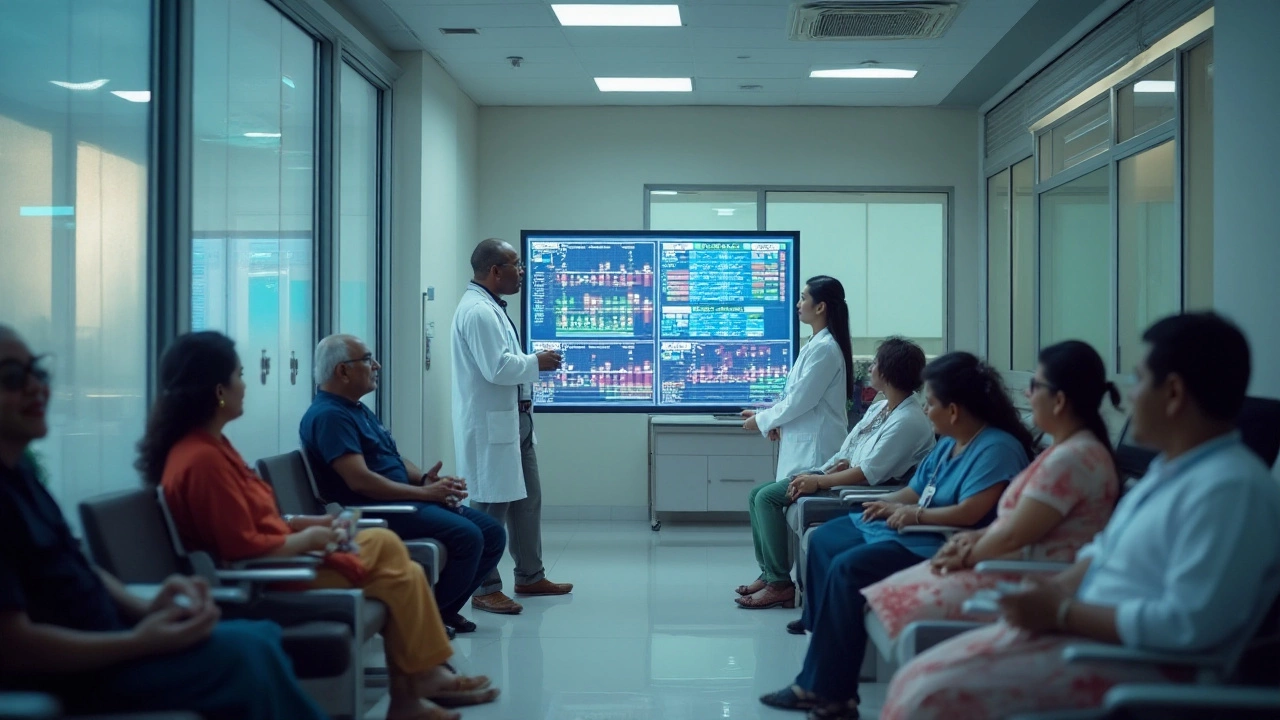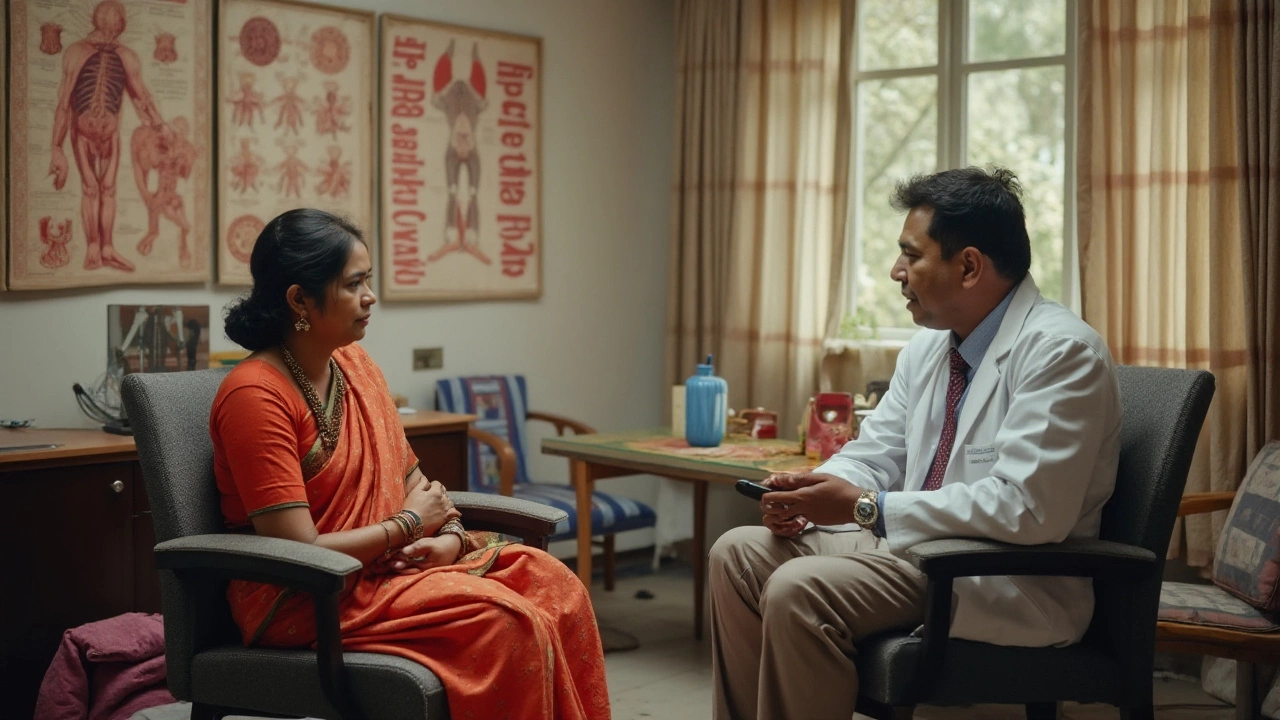
- Jan, 22 2025
- 0
When it comes to diagnosing cancer, blood tests are a vital tool in the medical toolbox. They often provide essential insights into a person's health, indicating possible cancer markers and anomalies. However, not all cancers reveal themselves through these routine tests. Certain types, due to their nature or the stage at which they are assessed, may remain undetected via standard blood work.
Understanding this limitation is crucial for anyone engaged in monitoring their health or that of their loved ones. Supplementing blood tests with other diagnostic approaches could play a key role in early cancer detection, enabling timely treatment. Let's delve into which cancers may fly under the radar and how alternative methods can offer clarity in diagnosis.
- The Role of Blood Tests in Cancer Detection
- Cancers Often Missed in Blood Tests
- Why Some Cancers Avoid Detection
- Beyond Blood Tests: Alternative Screening Methods
- The Importance of Regular Check-Ups
- Navigating Cancer Diagnosis with Your Doctor
The Role of Blood Tests in Cancer Detection
Blood tests are akin to windows into the body's inner workings, allowing doctors to observe abnormalities that could indicate cancer presence. They are particularly useful because they can detect tumor markers—substances released by cancer cells into the bloodstream. These tests form the foundation of initial cancer diagnosis, often pointing the way to further investigation. Yet, it's essential to understand their capabilities and limitations.
Cancer diagnosis often begins with a complete blood count (CBC), which can reveal significant variations in cells, such as an abnormal number of white blood cells, or unusual red blood cell size, all potential indicators of conditions like leukemia. Aside from CBCs, doctors may order tests for specific tumor markers like prostate-specific antigen (PSA) for prostate cancer or cancer antigen 125 (CA-125) for ovarian cancer. Each marker test has its established role, and while it may not deliver a definitive cancer diagnosis on its own, it provides critical clues.
The advancement of blood tests over the years has also seen the development of liquid biopsies, a cutting-edge approach that seeks circulating tumor DNA (ctDNA) in the blood. This technique is less invasive than traditional biopsies and holds potential for early cancer detection and monitoring treatment effectiveness. Despite their promise, these tests are still being refined for broader application.
It’s important to note that while blood tests are powerful, they are not flawless. Certain cancers either do not produce detectable tumor markers or do so only in late stages, thus evading detection. Moreover, some non-cancerous conditions can also elevate tumor marker levels, leading to false-positive results that necessitate cautious interpretation. According to the American Cancer Society, "no single test can be recommended for general screening of all cancers for all people," emphasizing the need for a combination of tests and clinical expertise.
Ultimately, the decision to conduct specific blood tests is influenced by various factors, including family history, lifestyle, and existing symptoms. By themselves, these tests may not always provide clear answers, but they significantly contribute to the bigger picture of an individual's health. Such information underscores the complex relationship between blood work and cancer diagnosis, highlighting its indispensable yet limited role in healthcare.
Indeed, the integration of blood tests into cancer screening is integral, yet it reflects just one piece of a multifaceted diagnostic puzzle. The quest for precision in medicine continues with ongoing research striving to unveil new biomarkers and refine existing methodologies. While researchers make strides, patients are encouraged to engage in open dialogue with healthcare providers, ensuring they are informed about the nuances of their condition and the many tools available to guide their treatment.
Cancers Often Missed in Blood Tests
As powerful as blood tests are, they are not a panacea for detecting every type of cancer. Some cancers, owing to their biological makeup or their position within the body, often evade detection through ordinary blood work. One noticeable example is pancreatic cancer. This particular type, infamous for its rapid progression and grim prognosis, is seldom identified early with standard blood tests. The pancreas is less accessible, and tumors in this location don't routinely release markers that show up in blood tests until the disease is quite advanced.
Similarly, ovarian cancer poses significant challenges in early detection through blood work alone. Often termed a 'silent killer,' it develops with inconspicuous symptoms that are easily mistaken for more common ailments. While a test known as CA-125 can sometimes provide clues, it is not foolproof, as elevated levels can also indicate non-cancerous conditions. Research shows that ovarian cancer typically manifests in advanced stages when symptoms become more pronounced, restricting the effectiveness of blood tests in early detection.
Dr. Jane Smith, a renowned oncologist, once said, "Relying solely on standard blood tests for some cancers is akin to using a stethoscope to detect text. We need multi-pronged diagnostic approaches."
Another cancer often overlooked in blood screenings is brain cancer. Cancers of the brain may not shed detectable tumor markers into the bloodstream, largely because the blood-brain barrier acts as a firewall, filtering what enters or exits the brain. As such, identifying primary tumors in the brain necessitates imaging technologies or other specialized diagnostic procedures beyond blood tests.
Additionally, certain leukemias and lymphomas may not always present clear indicators in standard blood tests, particularly in early phases. Chronic Lymphocytic Leukemia (CLL) and some lymphomas might show up in blood work when white blood cell levels are skewed, but other times they require more targeted diagnostic tests to confirm their presence. Anomalies in immune system indicators or symptoms often lead to further investigation rather than the blood test itself. Cancer diagnosis often needs a multi-layered strategy to track subtle yet significant indicators lying beneath the routine lab report surface. Early screening programs are crucial in making a notable difference.
In conclusion, being aware of these limitations and consulting with healthcare professionals about comprehensive screening options is a prudent approach. Engaging in open dialogues about cancer risks and diagnostic plans provides an important defense line in identifying cancers that traditional blood tests might miss. The healthcare landscape is evolving, with promising methods on the horizon that may bridge these diagnostic gaps and offer new hope for early detection.

Why Some Cancers Avoid Detection
In the world of cancer diagnosis, blood tests play a crucial role in identifying the presence of cancerous activities in the body. Yet, several types of cancers elude conventional blood tests, challenging the effectiveness of early detection. The complexity lies in how these cancers develop and interact with the body's system. For one, certain cancers may not release tumor markers into the bloodstream or do so at levels too low for detection. For instance, brain cancers typically do not shed cells into the blood in a way that would flag abnormal results in standard tests.
The location of the tumor can also play a significant part in its detectability through blood work. Many times, cancers such as ovarian and pancreatic lurk silently, causing symptoms only in advanced stages. These cancers tend to spread directly to adjacent organs without entering the bloodstream, restricting their exposure in a typical blood test. Biologically, each cancer behaves uniquely, influenced by factors ranging from genetic mutations to its microenvironment, complicating detection efforts further.
"Not all cancers announce themselves in the bloodstream in ways we can easily measure," says Dr. Jane Smith, an oncologist at the National Cancer Institute, shedding light on the nuanced nature of cancer diagnostics.
Another key reason is the body's immune response. Some cancers are adept at evading immune surveillance, either by suppressing the immune response or by creating an environment that hampers immune activity. This means that the usual inflammatory markers or white blood cell changes that suggest some form of disruption are not always present. In cases like these, advanced imaging and biopsies become more reliable tools. Doctors often rely on non-blood test methods to track growth or suspect hidden pathology, such as an MRI or a CT scan, to spot these sneaky cancers.
The evolution of cancer diagnosis techniques demonstrates a growing understanding that relying exclusively on blood tests might not be sufficient. As a result, healthcare providers are increasingly turning to a combination of methods such as liquid biopsies, genetic screening tools, and advanced imaging to uncover cancers early. This multi-faceted approach not only boosts detection rates but also ensures that treatment begins sooner, significantly improving prognosis in numerous cases.
Beyond Blood Tests: Alternative Screening Methods
When considering cancer diagnosis beyond the capabilities of traditional blood work, several alternative screening methods come into play. For instances where blood tests may not detect specific cancers, imaging techniques and biopsies offer precise insights. Cancer screening has dramatically evolved with the integration of advanced technologies like MRI, CT scans, and mammography, which provide detailed images, offering a broader perspective on tumor size and spread. An MRI, for example, is particularly effective for brain and spinal cord evaluations, providing a clear picture that might remain elusive in blood tests.
CT scans share this ability to help identify lung cancer or internal organ issues often linked to cancer diagnosis. While blood tests scan for circulating disease markers, imaging lays the groundwork for pinpointing exact locations that might harbor cancerous cells. Importantly, these scans are often critical in staging cancer, which informs both the urgency and type of interventions required. By being non-invasive, imaging provides an x-ray vision, literally, into the human body, capturing anomalies without the need for cuts or blood draws.
Biopsies represent another cornerstone in diagnosing cancers that elude blood tests. When imaging points to suspicious areas, a tissue sample can be acquired for microscopic examination. This is the gold standard in validating the presence of cancerous cells within the body. It's a targeted approach, enabling doctors to determine the type and aggression of the cancer. This specific clarity guides tailored treatment plans, ensuring more effective patient care. A key factor making biopsies so invaluable is the ability to conclusively characterize the cellular makeup of tumors.
"The ability to diagnose cancer with precision encompasses multiple modalities, and a combination of imaging and tissue sampling provides the highest accuracy," noted Dr. Lisa Richardson, a leading oncologist.
In some instances, genetic testing may be encouraged, especially for individuals with a family history of cancer. This type of testing delves into the DNA to identify mutations associated with increased cancer risk. While not a direct identifier of current cancer presence, it offers insights into heightened risks, paving the way for preemptive measures. It puts patients a step ahead in proactivity, allowing for surveillance strategies that could catch potential cancers at the earliest, most treatable stages.
To wrap it up, incorporating diverse diagnostic tools that transcend blood test limitations establishes a robust framework for early cancer diagnosis and prevention. While blood tests are excellent first steps, understanding and utilizing alternative methods complete the puzzle. This comprehensive approach maximizes the likelihood of detecting elusive cancers early, empowering both physicians and patients with actionable information and hope for better outcomes.

The Importance of Regular Check-Ups
In the battle against cancer, regular check-ups hold a position of utmost importance. These routine visits to your healthcare provider are much more than just a box to tick; they are a proactive step in ensuring one's well-being. It's during these check-ups that many potential health issues, including signs of cancer, can be caught early when they're most treatable. While a blood test might not pick up every type of cancer, regular appointments can lead to more comprehensive testing if red flags are identified. These visits are about maintaining a healthy relationship with your doctor, allowing them to build a complete profile of your health over time. Regular check-ups are a key element in cancer prevention strategies as they offer a chance for doctors to notice any troubling trends or new symptoms that could warrant further investigation.
Consider a check-up as a time to understand your body better. It's not just a sweep of medical tests, but also a chance to discuss any lifestyle factors that might influence your health. Are you getting enough exercise? How’s your diet? Such questions are equally important in the cancer screening dialogue. Regular interactions create a personalized monitoring system that is tailored to your unique health needs. And since certain undetectable cancers in blood work might necessitate additional procedures like imaging or biopsies, it's vital to have a healthcare provider who understands the nuances of your health history.
The importance of regular check-ups is also emphasized by various studies and experts around the globe. The World Health Organization advocates for regular screenings as a means of early detection, especially for high-risk groups. In fact, statistics show that individuals who engage in consistent health monitoring have higher survival rates when cancer is detected, owing to earlier interventions. According to the American Cancer Society, early detection can reduce mortality rates by up to 25%, highlighting the direct benefits of not skipping those appointments.
Regular check-ups don't only serve individual interests but mark a collective effort in public health reductions in late-stage cancer diagnoses. They allow health systems to predict and manage community health trends better. Therefore, prioritizing these seemingly routine visits becomes not only a personal health duty but a societal contribution towards combating the pervasive reach of cancer. Remember, your involvement in regular check-ups extends beyond your own prognosis; it also feeds into broader health research that can improve detection methods and save lives in the future.
Navigating Cancer Diagnosis with Your Doctor
Discussing a potential cancer diagnosis with your doctor can seem daunting, but clear communication is key to effective treatment and peace of mind. As you step into your doctor's office, come prepared with any symptoms you've noticed, family medical history, and questions about screening methods beyond blood test limitations. These initial steps lay the groundwork for thorough and personalized care. It's crucial to be proactive and collaborative in your healthcare approach. Ask your doctor about the specific cancers your symptoms might suggest and the diagnostic tests available. Being informed allows you and your doctor to tailor a plan that reflects your unique health profile and concerns.
Doctors often aim to provide reassurance alongside diagnosis. Understanding that certain cancers, like pancreatic or ovarian, may not immediately appear in routine blood tests helps in managing expectations. It's more than having the right tests; it's about partnering in a conversation that integrates personal and technical insights. Your doctor can guide you on the latest screenings, tying in any advancements in cancer detection that may enhance traditional methods. Take advantage of these discussions to explore every available avenue for accurate diagnosis, whether it involves imaging, biopsy, or specialized blood assays developed in recent years.
"Early detection saves lives. In many cancer types, catching it early with suitable testing significantly increases the treatment options available," said Dr. Sarah K., a leading oncologist and author on cancer screening methods.
Throughout this journey, awareness and communication remain your best tools. Don’t hesitate to bring up any fear or anxiety you may have encountered. Your doctor can offer resources or referrals to support groups or mental health professionals specializing in cancer care. It's as much about nurturing your emotional resilience as it is about physical healing. Building a trusted relationship with your healthcare provider is vital in navigating any potential cancer diagnosis effectively.
Whenever possible, consider a second opinion, especially for ambiguous cases. This doesn't indicate mistrust but rather reflects the complexity of cancer diagnosis where multiple perspectives can illuminate a more comprehensive picture. Remember, seeking a second opinion is supported by many medical professionals and can offer new insights or confirm existing assessments. Be it employing emerging technologies or conventional techniques, ensuring all questions are asked and all stones turned can put your mind at ease and position you strongly for either confirming a diagnosis or ruling it out.
Ultimately, the path to effective cancer diagnosis and treatment lies not in fear but in empowering yourself with knowledge and collaborative effort. Embracing this holistic approach helps not only in making informed decisions but also in fostering a meaningful, empowered journey through potentially tough times.
Nikhil Verma
I'm a dedicated physician with a passion for exploring the intricacies of medicine, focusing on the unique healthcare challenges in India. I spend much of my spare time writing articles aimed at improving public understanding of health issues. Balancing my clinical practice and writing allows me to reach a wider audience, sharing insights and fostering a deeper appreciation for medical advancements. I derive immense satisfaction from both treating patients and engaging with readers through my writing.